 |
 |
|
» Back to Main Page » The Auction » The Winning Bid » All About Madidi » The Scientist and the Monkey » 60 Minutes Seeks The Monkey » WCS Protects Madidi Land And Species » The GoldenPalace.com Monkey » How the Monkey was Discovered » Scientists Observe Monkeys » Focus on Madidi's Diverse Wildlife  |
How WCS Helps To Protect Madidi Land And Species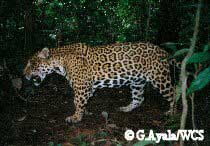 Madidi is the spectacular centerpiece to a wild landscape that spans two countries, five protected areas and more than seven indigenous groups and their respective territories. Conserving wildlife across the vast Madidi landscape requires the coordination of efforts among indigenous groups, government officials, non-governmental organizations and other local stakeholders. The conservation model WCS has helped develop for Madidi revolves around participatory management, in which all of these groups have a say in decision-making. In this manner we can protect Madidi’s biodiversity and cultural values. For the last five years, WCS has been working with national authorities and local organizations towards three main objectives:
Madidi is the spectacular centerpiece to a wild landscape that spans two countries, five protected areas and more than seven indigenous groups and their respective territories. Conserving wildlife across the vast Madidi landscape requires the coordination of efforts among indigenous groups, government officials, non-governmental organizations and other local stakeholders. The conservation model WCS has helped develop for Madidi revolves around participatory management, in which all of these groups have a say in decision-making. In this manner we can protect Madidi’s biodiversity and cultural values. For the last five years, WCS has been working with national authorities and local organizations towards three main objectives:
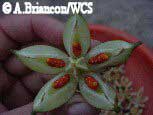 Protecting a landscape as large and complex as Madidi is an extreme challenge. WCS focuses on protecting wide-ranging “landscape” species, because if we can protect them, we will succeed in addressing threats facing large swaths of critical habitats, other wildlife and the local communities that are ultimately responsible for the magnificent landscape.
Protecting a landscape as large and complex as Madidi is an extreme challenge. WCS focuses on protecting wide-ranging “landscape” species, because if we can protect them, we will succeed in addressing threats facing large swaths of critical habitats, other wildlife and the local communities that are ultimately responsible for the magnificent landscape.
WCS focuses on the following landscape species: jaguar, spectacled bear, white-lipped peccary, Andean condor and vicuña. Each species plays a key ecological role in the landscape, but also represents an economic opportunity and/or threat to local communities. Thus they are at the heart of our work. 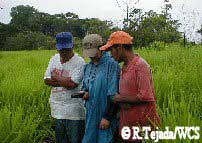 But how do we protect these species? How big are their populations? What types of habitat do they prefer? How much land do we need to protect to prevent these species from going extinct? To answer these questions, WCS generates basic information on landscape species’ distribution, population sizes, habitat preferences and the amount of space individual animals require for survival. For example, in 2005, we will conduct an Andean condor census, continue jaguar and spectacled bear surveys using camera-traps, radio-track jaguars and white-lipped peccaries, and conduct a health and genetics survey of vicuñas in conjunction with the WCS Field Veterinary Program.
But how do we protect these species? How big are their populations? What types of habitat do they prefer? How much land do we need to protect to prevent these species from going extinct? To answer these questions, WCS generates basic information on landscape species’ distribution, population sizes, habitat preferences and the amount of space individual animals require for survival. For example, in 2005, we will conduct an Andean condor census, continue jaguar and spectacled bear surveys using camera-traps, radio-track jaguars and white-lipped peccaries, and conduct a health and genetics survey of vicuñas in conjunction with the WCS Field Veterinary Program.
Because wildlife species that range widely frequently cross park boundaries, we need to understand and manage their relationship with local people. In the highlands of the Madidi landscape, community livestock farmers and agricultural activities are often in conflict with the local wildlife because of livestock kills and crop raiding. For example, local communities complain that spectacled bears raid their maize crops and hunt their cattle. This is a major problem because when locals perceive wildlife as a threat, they will persecute alleged perpetrators including threatened species such as the spectacled bear, jaguar, Andean condor, Andean fox and puma. 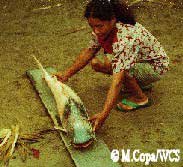 WCS aims to investigate human-wildlife conflict and develop solutions. We work with local communities to measure and monitor these problems and develop realistic, cost-efficient methods to manage the conflicts. For example, we are working with herders in the Apolobamba highlands to build corrals for their alpacas and llamas to sleep in at night, when they are most susceptible to predation by Andean foxes and pumas. We also show communities how they can benefit from healthy wildlife populations through ecotourism, sustainable hunting and other initiatives.
WCS aims to investigate human-wildlife conflict and develop solutions. We work with local communities to measure and monitor these problems and develop realistic, cost-efficient methods to manage the conflicts. For example, we are working with herders in the Apolobamba highlands to build corrals for their alpacas and llamas to sleep in at night, when they are most susceptible to predation by Andean foxes and pumas. We also show communities how they can benefit from healthy wildlife populations through ecotourism, sustainable hunting and other initiatives.
WCS Madidi: Sustainable Natural Resource Management Given the poor economic situation of western Bolivia, local people are desperate for development opportunities. To reconcile this need with the preservation of the landscape, the Madidi management plan incorporates economic, social and environmental benefits for the local populations through sustainable development initiatives. WCS works with a variety of natural resource management initiatives in the region, largely at the community level. 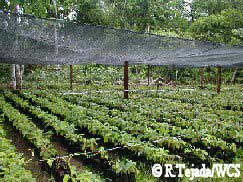 Community ecotourism is a key economic activity in Madidi. Examples include the successful Chalalán lodge and the most recent San Miguel ecotourism project. WCS has played an active role in the establishment of tourism regulations (e.g., basic codes of conduct) and the training of guides, and Madidi is now one of the major tourist attractions of Bolivia. Last year more than US $33,000 was generated in tourist entrance fees, which help fund park protection.
Community ecotourism is a key economic activity in Madidi. Examples include the successful Chalalán lodge and the most recent San Miguel ecotourism project. WCS has played an active role in the establishment of tourism regulations (e.g., basic codes of conduct) and the training of guides, and Madidi is now one of the major tourist attractions of Bolivia. Last year more than US $33,000 was generated in tourist entrance fees, which help fund park protection.
The region also harbors a number of non-timber forest and wildlife products which WCS helps communities harvest at sustainable levels. Examples include:
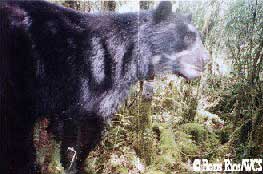 Incense production can be profitable for locals. We are working with several communities to better manage products with existing local markets. In this manner, local communities can benefit economically from preserving the surrounding forests.
Incense production can be profitable for locals. We are working with several communities to better manage products with existing local markets. In this manner, local communities can benefit economically from preserving the surrounding forests.
Dorado is a commercially important fish in the lowlands of Madidi. In the lowlands of Madidi, WCS works with the Tacana, Moseten and Tsimane indigenous groups to manage important game species such as peccary, tapir and deer. Effective management is critical for wildlife but also for these indigenous communities that rely on bushmeat for food. WCS community projects include developing management and monitoring capacity within the local communities and designating hunting areas as well as wildlife reserves within community lands. |
 |
|
| Copyright © 2026 GoldenPalaceMonkey.com. All rights reserved. This site is in no way affiliated with WCS.org. |
|
